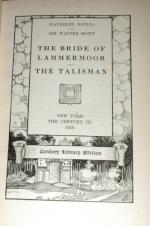In all Stair’s
offspring we no difference know,
They do the females
as the males bestow;
So he of one of his
daughters’ marriages gave the ward,
Like a true vassal,
to Glenluce’s Laird;
He knew what she did
to her master plight,
If she her faith to
Rutherfurd should slight,
Which, like his own,
for greed he broke outright.
Nick did Baldoon’s
posterior right deride,
And, as first substitute,
did seize the bride;
Whate’er he to
his mistress did or said,
He threw the bridegroom
from the nuptial bed,
Into the chimney did
so his rival maul,
His bruised bones ne’er
were cured but by the fall.
One of the marginal notes ascribed to William Dunlop applies to the above lines. “She had betrothed herself to Lord Rutherfoord under horrid imprecations, and afterwards married Baldoon, his nevoy, and her mother was the cause of her breach of faith.”
The same tragedy is alluded to in the following couplet and note:
What train of curses that base brood pursues, When the young nephew weds old uncle’s spouse.
The note on the word “uncle” explains it as meaning “Rutherfoord, who should have married the Lady Baldoon, was Baldoon’s uncle.” The poetry of this satire on Lord Stair and his family was, as already noticed, written by Sir William Hamilton of Whitelaw, a rival of Lord Stair for the situation of President of the Court of Session; a person much inferior to that great lawyer in talents, and equally ill-treated by the calumny or just satire of his contemporaries as an unjust and partial judge. Some of the notes are by that curious and laborious antiquary, Robert Milne, who, as a virulent Jacobite, willingly lent a hand to blacken the family of Stair.
Another poet of the period, with a very different purpose, has left an elegy, in which he darkly hints at and bemoans the fate of the ill-starred young person, whose very uncommon calamity Whitelaw, Dunlop, and Milne thought a fitting subject for buffoonery and ribaldry. This bard of milder mood was Andrew Symson, before the Revolution minister of Kirkinner, in Galloway, and after his expulsion as an Episcopalian following the humble occupation of a printer in Edinburgh. He furnished the family of Baldoon, with which he appears to have been intimate, with an elegy on the tragic event in their family. In this piece he treats the mournful occasion of the bride’s death with mysterious solemnity.
The verses bear this title, “On the unexpected death of the virtuous Lady Mrs. Janet Dalrymple, Lady Baldoon, younger,” and afford us the precise dates of the catastrophe, which could not otherwise have been easily ascertained. “Nupta August 12. Domum Ducta August 24. Obiit September 12. Sepult. September 30, 1669.” The form of the elegy is a dialogue betwixt a passenger and a domestic servant. The first, recollecting that he had passed that way lately, and seen all around enlivened by the appearances of mirth and festivity, is desirous to know what had changed so gay a scene into mourning. We preserve the reply of the servant as a specimen of Mr. Symson’s verses, which are not of the first quality:




